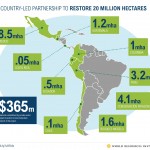By Ann Tutweiler, originally posted at Bioversity International
If all of the globe’s degraded land were put together, it would constitute an area the size of South America. Major global actors are taking note. Restoring productivity to these lands, in particular using trees, would mean greater food and water security, sequestration of billions of tons of carbon, livelihoods for millions of people, and reduced or reversed biodiversity loss.
Governments around the world are signing onto highly ambitious goals to restore treed landscapes over vast areas of degraded and deforested land. If the promises exemplified by Aichi Target 15, the Bonn Challenge, the New York Declaration, the Great Green Wall, Initiative 20×20 and others are realized, the result will be hundreds of millions of hectares restored to a productive state.

Bioversity International is a partner in Initiative 20×20, working with the World Resources Institute (WRI), the International Union for Conservation of Nature (IUCN), the International Center for Tropical Agriculture (CIAT) and the Tropical Agricultural Research and Higher Education Centre (CATIE) to help countries meet their objectives of 20 million hectares of land in Latin America restored by 2020. The initiative was launched formally at COP 20 in Lima in December 2014 (at the 2014 Global Landscapes Forum), and I had the opportunity to visit WRI and IUCN partners in Washington earlier this month to discuss common aims and approaches.
Watch video of WRI Senior Fellow Walter Vergara talking about the 20×20 initative
The scale of the current commitments presents great opportunities, but successful restoration of degraded land to a productive, functional and self-sustaining state is not easily achieved. In the past, many restoration efforts have failed for a variety of reasons, including use of planting materials that are not suited to the restoration site. Little attention is often paid to matching the characteristics of planting material – for example, the ability to tolerate drought – to the conditions at the planting sites.
In addition, seed for restoration is often collected from very few trees that are in close physical proximity to each other, so often that means that the seed parents are related and the offspring are inbred and lack diversity.
Genetic diversity is important for two reasons. First, unlike many agricultural crops, trees do not perform well if they are inbred. In fact inbreeding often results in poor growth, greater susceptibility to stress and serious reproductive problems. Second, to restore a self-sustaining forest ecosystem, the planting material must have sufficient genetic diversity to avoid inbreeding and to have the capacity to adapt to changing conditions, including future climates.
Success in restoration initiatives is often reported simply as number of trees or hectares planted, but these measures do not necessarily indicate long-term success. Of course many factors influence whether restoration initiatives will successfully achieve ecological and livelihood-related goals, but starting with the right planting material – well matched and diverse – is fundamental.
Read full blog here











